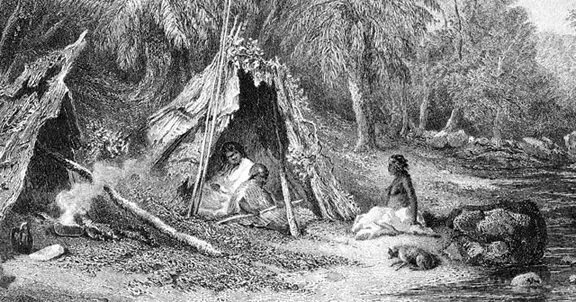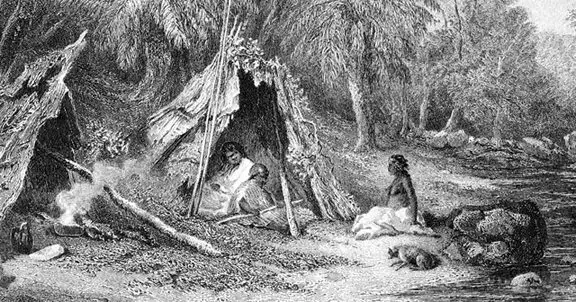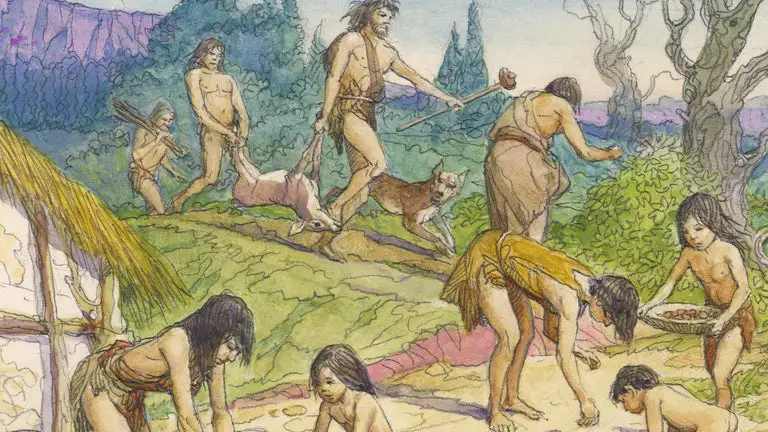Hunter-gatherers lived in various geographical regions around the world, including forests, grasslands, deserts, and Arctic tundra. They adapted to their surroundings and relied on hunting wild animals and gathering edible plants for sustenance.
The Basic Concept Of Hunter-Gatherers
The basic concept of hunter-gatherers revolves around their unique lifestyle and practices of living off the land. Hunter-gatherers were nomadic societies that relied on hunting animals and gathering plants as their primary means of subsistence. This lifestyle required them to adapt to the natural environment in which they lived.
Unlike agricultural societies, hunter-gatherers did not engage in the cultivation of crops. Instead, they moved from place to place in search of food sources. They had an intimate understanding of their surroundings and the various resources available to them, allowing them to sustain their communities.
Hunter-gatherers inhabited diverse regions across the globe, from the lush forests of Central Africa to the frigid Arctic tundra. Their adaptability enabled them to thrive in different ecosystems, utilizing the resources available in each area.
Their way of living, relying on the natural bounty around them, allowed hunter-gatherers to form deep connections with their environment. Their practices and knowledge were often passed down through generations, creating a rich cultural heritage that continues to fascinate archaeologists and anthropologists today.
The Geographical Distribution Of Hunter-Gatherer Societies
The geographical distribution of hunter-gatherer societies varied across different continents. Factors such as climate, availability of resources, and environmental conditions influenced their settlements. Various case studies highlight prominent hunter-gatherer communities around the world.
In Africa, hunter-gatherer societies were found in regions such as the Kalahari Desert, the Congo Basin, and the Sahara. The San people in southern Africa and the Pygmies in Central Africa are examples of well-known hunter-gatherer communities.
In Asia, the Aeta people in the Philippines and the Sentinelese in the Andaman Islands are notable hunter-gatherer communities. In Australia, the Aboriginal people practiced hunting and gathering for thousands of years, adapting to the harsh desert environment.
The indigenous peoples of North America, such as the Native American tribes, relied extensively on hunting and gathering before the arrival of European settlers. In South America, the Yanomami in the Amazon rainforest have sustained a hunter-gatherer lifestyle for centuries.
Overall, the distribution of hunter-gatherer societies was influenced by a multitude of factors, shaping unique settlements and cultures across continents.
Hunter-Gatherer Habitats And Shelters
Hunter-gatherers inhabited various terrains and environments. They were known for their nomadic lifestyle, adapting to different locations based on seasons. The movement of these groups was influenced by the availability of resources such as food and water.
Hunter-gatherer shelters and dwellings were simple and practical, designed to meet their immediate needs. These structures varied depending on the region and materials available. In warm climates, temporary huts made from branches and leaves provided shelter. For colder climates, caves, rock shelters, or small huts with animal skin coverings helped preserve heat.
It is fascinating to see the adaptability and resourcefulness of hunter-gatherer communities. They made use of available materials and designed their shelters in a way that fit their lifestyles and environments.

Credit: www.history.com
Forest And Jungle Habitats
Forest and jungle habitats have long been home to various hunter-gatherer communities. These environments offer a unique set of challenges and opportunities for survival. Forest adaptations and resources play a crucial role in the thriving of hunter-gatherer societies.
Skills for thriving in jungle environments include navigation through dense foliage, familiarization with local flora and fauna, and knowledge of natural resources for sustenance and shelter. Hunter-gatherers living in forests have developed an intricate understanding of their surroundings, utilizing plants for food, medicine, and tools.
Examples of forest dwelling hunter-gatherers include the Batek people of Malaysia, who inhabit the rainforests of Peninsular Malaysia. They rely on a combination of hunting, gathering, and fishing to sustain their communities. Similarly, the Aka people of Central Africa are skilled hunters and gatherers, utilizing their expertise to navigate the dense rainforests they call home.
Coastal And Marine Environments
Lorem ipsum dolor sit amet, consectetur adipiscing elit. Nulla commodo ultricies ante, a vulputate diam commodo vitae. Morbi varius semper felis, nec dapibus velit porttitor ac. Sed quis velit massa. Sed vel dolor eget risus lacinia pellentesque. Nunc vel euismod erat, sit amet eleifend tortor. Vestibulum urna nulla, lobortis ac felis non, efficitur ultrices nibh. Nullam elementum finibus justo id aliquam. Donec at tellus eu justo ultrices porta vel bibendum elit. Suspendisse placerat tellus at purus bibendum, quis elementum ex ultrices. Mauris aliquam, ex non pharetra lobortis, odio lacus feugiat dui, ut pharetra purus mauris a odio. Etiam pretium diam vel turpis pulvinar condimentum. Nam elementum turpis urna, in posuere nisi venenatis a.
Vestibulum sit amet auctor enim. Nam sed purus consectetur, accumsan arcu non, lobortis urna. Cras eu erat facilisis, varius leo id, maximus tortor. Curabitur finibus volutpat malesuada. Nullam fermentum purus a sem ultrices tristique. Sed lacinia quam et dolor suscipit, vitae fermentum urna ornare. Cras gravida congue mi eget rhoncus. Curabitur ut porttitor metus, sit amet ultrices metus.
Nulla euismod eu elit ut porta. Phasellus posuere molestie semper. Nam tempor consectetur lacus, eu accumsan felis porta vel. Sed sed sollicitudin tortor, ac mattis lectus. Pellentesque habitant morbi tristique senectus et netus et malesuada fames ac turpis egestas. Integer posuere varius velit id lobortis. Maecenas pulvinar iaculis orci, et volutpat lacus viverra non. Quisque dictum molestie mi id pharetra.
| Coastal Adaptations and Resources Utilized | Fishing Techniques and Tools | Notable Hunter-Gatherer Communities Living by the Sea |
|---|---|---|
| Aquatic resources like fish, shellfish, seaweed were utilized by coastal hunter-gatherers for sustenance. | Fishing techniques used by hunter-gatherers included spears, harpoons, nets, and traps to catch marine life. | The Inuit people of the Arctic, the Chumash people of California, and the indigenous people of the Pacific Northwest were notable coastal hunter-gatherer communities. |
| Coastal environments provided a diverse range of food sources, allowing hunter-gatherers to adapt their diets. | Tools such as fish hooks, bone needles, and canoes were developed to aid in fishing activities. | The Maori people of New Zealand and the Aboriginal people of Australia also relied on coastal resources for their livelihood. |
Grasslands And Plains
Grasslands and plains were popular habitats for hunter-gatherer communities throughout history. These open landscapes provided ample resources for their survival. Hunter-gatherers in such areas developed specialized techniques for game hunting and gathering, honing their skills to adapt to the environment. By understanding the behavior and migration patterns of animals, they were able to successfully trap and hunt for food. Additionally, they gathered edible plants, fruits, and nuts from the surrounding areas. In the plains, there were well-known groups of hunter-gatherers who adapted to this unique environment. The Plains Indians of North America, for example, relied on buffalo hunting for their sustenance and utilized all parts of the animal for various purposes. These communities displayed remarkable resourcefulness and mastery of the grasslands. Overall, grasslands and plains offered hunter-gatherers diverse opportunities for survival, driving the development of their skills and expertise in game hunting and gathering techniques.
Arid And Desert Areas
Hunter-gatherer societies were able to survive and thrive in a variety of environments, including arid and desert areas. These regions presented unique challenges, but hunter-gatherers developed strategies to overcome them. One of the key concerns in arid regions was accessing and managing water sources. Hunter-gatherer societies in these areas often relied on natural water sources such as springs, rivers, or oases. They developed techniques to capture and store water, such as digging and maintaining wells or constructing simple dams and irrigation systems. These strategies allowed them to sustain their communities and thrive in otherwise harsh environments.
Some arid regions also gave rise to prominent desert-dwelling hunter-gatherer societies. These societies adapted their lifestyles to the specific challenges of desert living. They relied on their extensive knowledge of the desert ecosystem, including understanding the plants and animals that could be found in these regions. They developed efficient hunting and gathering techniques, and also utilized tools and clothing suited for desert conditions. These desert-dwelling hunter-gatherer societies had a deep understanding of their environment and were able to successfully extract resources necessary for their survival, despite the harsh conditions.
Arctic And Subarctic Regions
In the Arctic and Subarctic regions, hunter-gatherer societies were known for their resilience in coping with extreme cold and harsh conditions. These societies developed various strategies to thrive in their environments. **Hunting techniques** for Arctic game were adapted to target animals such as seals, polar bears, and whales. They utilized tools like harpoons, bows and arrows, and fishing gear made from materials available in their surroundings. Noteworthy Arctic hunter-gatherer cultures include the Inuit, Yupik, and Gwich’in peoples, each with their unique practices and adaptations. These cultures demonstrated incredible adaptability and knowledge, utilizing every available resource to survive in challenging conditions.
Factors Influencing The Choice Of Hunter-Gatherer Settlements
Factors influencing the choice of hunter-gatherer settlements were mainly determined by the availability of resources and seasonal variation, climate and environmental conditions, as well as social and cultural factors. Hunter-gatherer communities relied on the abundance and accessibility of food sources in their surroundings. They would settle in areas where resources such as edible plants, animals, and water were plentiful.
Climate and environmental conditions played a crucial role in determining suitable habitats for these communities. Regions with mild climates and diverse ecosystems provided better opportunities for survival and resource exploitation. The availability of water sources, such as rivers or lakes, was also a determining factor.
Social and cultural factors shaped the choice of settlements as well. Hunter-gatherer communities sought locations that offered security and easy access to trade routes, as well as proximity to other groups for social interactions and exchange of knowledge.
Overall, the choice of hunter-gatherer settlements was influenced by a combination of factors including resource availability, environmental conditions, and cultural considerations.
Modern Hunter-Gatherer Communities
Hunter-gatherer communities have existed for thousands of years and are still present in various parts of the world today. These modern hunter-gatherer societies provide insight into the past and offer a glimpse into how our ancestors lived. Contemporary examples of hunter-gatherer societies include the San people in Southern Africa, the Inuit in the Arctic, and the Aboriginals in Australia. These communities rely on gathering wild plants, hunting game, and fishing to meet their subsistence needs. However, the impact of modernization and globalization has significantly affected traditional hunter-gatherer lifestyles. Increased contact with the modern world has led to changes in their cultural practices, as traditional knowledge and practices are being lost over time. Many hunter-gatherer communities are facing challenges such as loss of land and resources, cultural assimilation, and the introduction of new diseases. Despite these challenges, efforts are being made to preserve and revive traditional hunter-gatherer lifestyles. Some organizations are working with these communities to promote cultural heritage, sustainable resource management, and economic opportunities that align with their traditional ways of life.
Frequently Asked Questions Of Where Did Hunter Gatherers Live
What Did Hunter-Gatherers Live In?
Hunter-gatherers lived in temporary shelters like caves or tents made from animal skins or plants.
Did Hunter-Gatherers Live In Houses?
Yes, hunter-gatherers did live in houses. They constructed simple shelters using materials available in their surroundings.
Where Do Hunters And Gatherers Live Today?
Hunters and gatherers currently inhabit various regions worldwide, including isolated areas, forests, and deserts.
Which Place Was Built By Hunter-Gatherers?
Hunter-gatherers built the place.
Conclusion
Hunter-gatherer societies played a crucial role in shaping human history. They existed all around the globe, adapting to diverse environments and living harmoniously with nature. From the forests of North America to the deserts of Africa and the jungles of Asia, these early humans thrived in various geographical locations.
Their ability to utilize their surroundings for sustenance allowed them to establish temporary settlements and move in search of resources as needed. Hunter-gatherers employed sophisticated knowledge and skills to locate food sources, build shelters, and create tools. While their lifestyles eventually evolved into more settled agricultural practices, their resilience and adaptability continue to inspire.
By studying these ancient societies, we gain a deeper understanding of our roots and the invaluable wisdom they inherited. Appreciating the legacy of hunter-gatherers can guide us toward a more sustainable future as we confront the environmental challenges of the present day.













